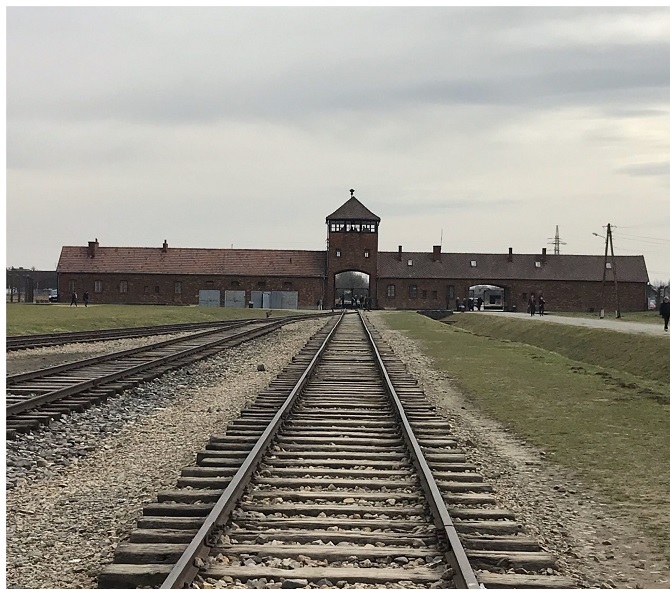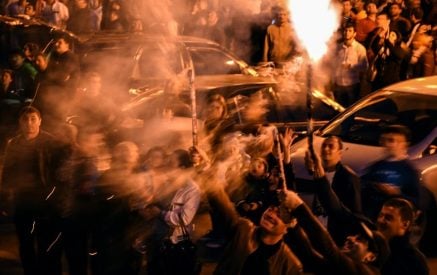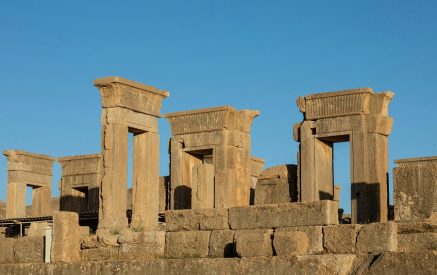The Armenian Weekly. I’ve actually been to Hell – well, this Hell wasn’t located in the fiery depths of the afterlife, but in the countryside on the outskirts of the baroque Polish city of Krakow.
Accompanying me on that chilly morning in March were my father and little sister. By the time we arrived under the black gates of Auschwitz, it was cold, grey and raining sporadically. The main entrance was packed with visitors – mostly from Israel. Hovering above my head I made out the phrase “Arbeit Macht Frei” (Work Sets You Free) cast in iron letters across the gate. That infamous slogan—an intentionally cruel attempt at irony—alludes to the camp’s official designation as a labor camp. Its true purpose, as we know today, was much more sinister.
Making our way through the neatly-set rows of brick-clad barracks that make up Auschwitz -1, the main camp in the complex, we witnessed a cramped room which at one time housed over 1,000 inmates, with a single toilet. Their pictures now cover the entire length of the wall. Further down, a brute cement wall riddled with bullet holes. “That’s the ‘Death Wall’,” our guide told us in a somber Polish-inflected voice. In the basement of one seemingly nondescript structure, matter-of-factly designated “Block 11,” we stopped in front of a dimly lit cell. There, 600 Soviet and 250 Polish prisoners of war had been murdered by the SS in 1941 as part of the Nazi’s first experiments with the ignominious cyanide-based poison Zyklon B. We moved on.
At the camp’s northeastern perimeter, a stone’s throw away from the ruins of the prototype crematorium, we passed by a stucco cottage, the residence of SS camp commander Rudolf Höss and his family throughout the most atrocious episodes of the “Final Solution.” Decades later, his daughter Brigitte Höss would fondly recall “eating together, playing in the garden, and reading the story of Hansel and Gretel” with her father.
Read also
The rest of the camp complex is equally ghastly, as one should expect: at Auschwitz II-Birkenau, we peered into the even more cramped bunks lining the walls of shoddily constructed barracks (hastily erected to accommodate Jews from territories newly captured in the East) and stood on the concrete train platforms where new inmates would be pulled from cattle cars and sent to the chambers (and ultimately, their deaths). But my story thus far echoes that of any Auschwitz visitor. Where’s the Armenian ‘angle’?
Well, the reason I’m writing all this is because of the contents of another building known as “Block 4.”
The first room in this otherwise unremarkable edifice contains human hair, tons and tons of it. The hair had been collected from the bodies of women and children who died in the gas chambers, cleaned in sal ammoniac and packaged awaiting transport to factories in Germany before the camp was liberated. In the next room there are piles over piles of personal items: suitcases, cigarette boxes, eyeglasses, gold teeth, paintings and shoes collected by the Sonderkommando. But the sight that remains permanently scorched into my memory is of a tiny pair of red shoes. They belonged to a two-year-old Jewish girl along with the matching coat and wool beret in the display case. My daughter Maral has little red shoes. She’s two years old.
I began to cry—silently, passionately—no one noticed, not even my father. All eyes were facing the floor. The last time I felt this unsettled was during my first, and last, visit to the Armenian Genocide Museum in Yerevan over a decade prior. Eventually, I grabbed ahold of myself, wiped off the warm tears from my cheeks and continued on.
The other distinct memory of that day is of my father. “The Germans knew better,” he repeatedly muttered to himself in angry disbelief as a young couple snapped a selfie in front of the collapsed gas chamber behind him. I knew what he meant. We never questioned the Turks’ propensity for barbarity, but the Germans gave us Bach and the Gutenberg Press.
Yet those red shoes would continue to haunt me. Over the days and months that followed, I replayed that moment in my mind, each time as fresh as if I was still there, in an attempt to come to terms with what I had experienced. Visiting a death camp should be a harrowing experience for anyone. But I am a descendant of an Armenian Genocide survivor. My experience had to be more profound. In retrospect, I think what struck me that day was empathy.
The particular feeling of empathy I’m alluding to here is difficult to describe, but it’s something Armenians may be singularly predisposed to recognize. I cried that day in Block 4 because that little girl could have been mine. I cried because those eyeglasses could have been my grandfather’s, the suitcases might have been my brother’s, and in a not-so-hyperbolic way, they were. On that day, I carried with me the same pain of arbitrary dehumanization, the same shame of being robbed of dignity, and the same absurdity of life’s disposability that my own grandfather was subjected to a mere quarter-century earlier. When I cried over the fate of these non-Armenians, I recognized their humanity as vividly as ever.
I’ve written before about the strange kinship of nations united in the shared experiences of genocide. But this story isn’t about solidarity between Armenians and Jews. It’s about solidarity between human beings. Too often, as time takes its toll, tragedy gives way to politics, and the experiences of victims of humanity’s most barbaric incidences of homo homini lupus become relegated to the role of building blocks in national narrative building.
It is perhaps fitting that this week marks the 75th anniversary of the liberation of Auschwitz concentration camp. Skimming through the headlines, the inevitable warnings of reinvigorated antisemitism and shameless historical revisionism on the part of one-time liberators, I think of the couple snapping a selfie atop the gas chamber. Three-quarters of a century is not that long ago, I realize, but long enough for living memory to pass into the banalities of history.
I also think about our own Auschwitz-Birkenau: Deir ez-Zor. The concentration camps set up by the Ottomans in that desolate stretch of the Syrian Desert served as the last stop for many of our own ancestors as they were pulled off cattle cars in 1915. The little chapel built on the site to house the remains of some of the victims had turned into a pilgrimage site in the years since, but I will never see it. In 2014, it was unceremoniously dynamited by ISIS.
But perhaps I don’t need to go to Deir ez-Zor, I think to myself as my daughter lies next to me in a tranquil sleep. Maybe I made my peace with my grandfather in a small village in southern Poland.
























































